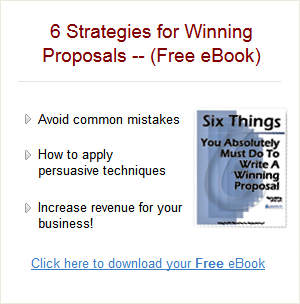The Most Important Section in Your Proposal
Which section is the most important one in your proposal? Some will say it’s the offer itself-the product or service you are proposing to your customer. Others will say it’s the pricing section-what the service will cost the customer. I’ve heard compelling arguments that the Executive Summary (or the cover letter, if you choose to write one instead of an ES) is the most critical. Heck. I’ve given arguments that the ES is the most important section.
You can make a good case for the project team section as the most important when you are proposing to conduct a project for the customer. Or the management section, or the relevant experience section, and on and on.
But lately I have been working on a proposal that made me realize what is really the most important section-or sections, with an “s”-in the proposal is. Are you ready? It’s the introductions. Not just the Introduction, with a capital “I”, but the short small “i” intros to the various sections of your proposal. The one-paragraph things that sort of transition the reader from one major idea to another. These paragraphs are absolutely critical.
Why critical? Three reasons:
- It makes your proposal more reader-friendly.
- It allows you to state the benefits up front to peak their interest.
- It makes your proposal more reader-friendly.
Remember that in most proposals not all of the people reading your proposal are interested in the same things. The technical reader wants to get to the technical stuff, The reader who will evaluate your costs is mainly interested in your pricing structure. The reader who is evaluating your proposal from a user’s perspective (if, for example, you’re proposing a software solution to a customer’s problem) will be most interested in the impacts your solution will have on the people who will use the solution once it’s in place.
Being reader-friendly means giving each reader a way to tell whether or not she needs to read the sections as she encounters them. The best way to do that is to provide a crisp summary that quickly spells out what the following sections will cover.
The following sections address the specific features of our software and how users can customize them to meet their unique requirements. Specifically, this section addresses how to use CommonSense to make changes to the common set of engineering tools distributed throughout the environment. It also discusses how to make specific modifications to the toolset on a given desktop unit. Finally, the last section addresses how individual users can modify the interface to meet their operational requirements.
This sort of a summary tells the reader what to expect in the sections that follow. Now she can make an informed decision: she can read for more detail, or she can move on to other sections that are more relevant to her.
Summaries also allow you to state the benefits up front to peak the readers’ interest. A summary is the perfect place to articulate your themes, your selling messages. Each section of your proposal should bolster the message(s) you want to send to the customer, your “why select us” pitch.
The summary of a given section should include at least one of the messages that you have decided will make the customer more inclined to select your product/service over the other guys’.
The following sections address the specific features of our software and how users can customize them to meet their unique requirements. Specifically, this section addresses how easy it is to use CommonSense to make changes to the common set of engineering tools distributed throughout the environment. These simple changes can help reduce the time it takes to process data while at the same time keeping the system updated.
This section also discusses how to make specific modifications to the toolset on a given desktop unit. This ability allows the user to configure the data input to match requirements, which reduces the amount of time the system administrator has to spend on configuring the system from incidence to incidence.
Finally, the last section addresses how individual users can make simple adjustments to modify the interface to meet their operational requirements. This means each user can format his system according to his own preference, which will make data input easier and will reduce the time it takes to perform necessary functions.
Effective proposal summaries not only tell the reader what they are going to see, but they enumerate the benefits as well. They entice the evaluator to read on, and give them a heads-up about the value to them of what they are about to read.

